
A more recent article on acute diarrhea in adults is available.
Am Fam Physician. 2014;89(3):180-189
Patient information: See related handout on diarrhea, written by the authors of this article.
Author disclosure: No relevant financial affiliations.
Acute diarrhea in adults is a common problem encountered by family physicians. The most common etiology is viral gastroenteritis, a self-limited disease. Increases in travel, comorbidities, and foodborne illness lead to more bacteria-related cases of acute diarrhea. A history and physical examination evaluating for risk factors and signs of inflammatory diarrhea and/or severe dehydration can direct any needed testing and treatment. Most patients do not require laboratory workup, and routine stool cultures are not recommended. Treatment focuses on preventing and treating dehydration. Diagnostic investigation should be reserved for patients with severe dehydration or illness, persistent fever, bloody stool, or immunosuppression, and for cases of suspected nosocomial infection or outbreak. Oral rehydration therapy with early refeeding is the preferred treatment for dehydration. Antimotility agents should be avoided in patients with bloody diarrhea, but loperamide/simethicone may improve symptoms in patients with watery diarrhea. Probiotic use may shorten the duration of illness. When used appropriately, antibiotics are effective in the treatment of shigellosis, campylobacteriosis, Clostridium difficile, traveler's diarrhea, and protozoal infections. Prevention of acute diarrhea is promoted through adequate hand washing, safe food preparation, access to clean water, and vaccinations.
Acute diarrhea is defined as stool with increased water content, volume, or frequency that lasts less than 14 days.1 Diarrheal illness accounts for 2.5 million deaths per year worldwide.2 In the United States, an estimated 48 million foodborne diarrheal illnesses occur annually, resulting in more than 128,000 hospitalizations and 3,000 deaths.3,4 In the developing world, infectious causes of acute diarrhea are largely related to contaminated food and water supplies.5 In the developed world, technological progress and an increase in mass production of food have paradoxically contributed to the persistence of foodborne illness, despite higher standards of food production.6
| Clinical recommendation | Evidence rating | References |
|---|---|---|
| In patients with acute diarrhea, stool cultures should be reserved for grossly bloody stool, severe dehydration, signs of inflammatory disease, symptoms lasting more than three to seven days, immunosuppression, and suspected nosocomial infections. | C | 25, 26 |
| Testing for Clostridium difficile toxins A and B should be performed in patients who develop unexplained diarrhea after three days of hospitalization. | C | 25, 27 |
| Routine testing for ova and parasites in acute diarrhea is not necessary in developed countries, unless the patient is in a high-risk group (i.e., diarrhea lasting more than seven days, especially if associated with infants in day care or travel to mountainous regions; diarrhea in patients with AIDS or men who have sex with men; community waterborne outbreaks; or bloody diarrhea with few fecal leukocytes). | C | 11, 29 |
| The first step to treating acute diarrhea is rehydration, preferably oral rehydration. | C | 1 |
| Combination loperamide/simethicone may provide faster and more complete relief of acute nonspecific diarrhea and gas-related discomfort than either medication alone. | B | 39 |
| Antibiotics (usually a quinolone) reduce the duration and severity of traveler's diarrhea. | A | 42 |
Differential Diagnosis
Infectious causes of acute diarrhea include viruses, bacteria, and, less often, parasites. Noninfectious causes include medication adverse effects, acute abdominal processes, gastroenterologic disease, and endocrine disease.
Clinically, acute infectious diarrhea is classified into two pathophysiologic syndromes, commonly referred to as noninflammatory (mostly viral, milder disease) and inflammatory (mostly invasive or with toxin-producing bacteria, more severe disease).7,8 Table 1 compares noninflammatory and inflammatory acute infectious diarrhea.7,8
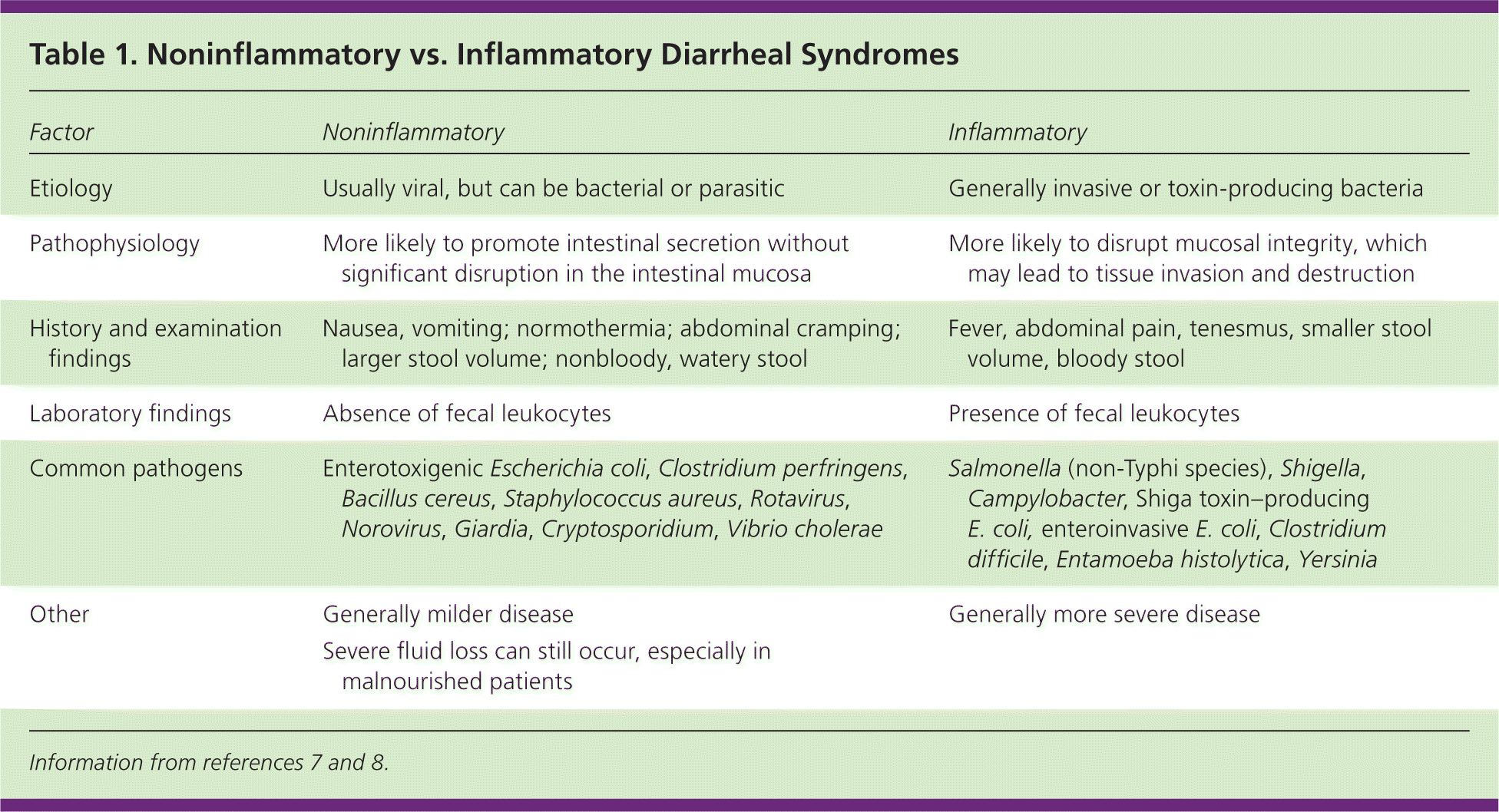
| Factor | Noninflammatory | Inflammatory |
|---|---|---|
| Etiology | Usually viral, but can be bacterial or parasitic | Generally invasive or toxin-producing bacteria |
| Pathophysiology | More likely to promote intestinal secretion without significant disruption in the intestinal mucosa | More likely to disrupt mucosal integrity, which may lead to tissue invasion and destruction |
| History and examination findings | Nausea, vomiting; normothermia; abdominal cramping; larger stool volume; nonbloody, watery stool | Fever, abdominal pain, tenesmus, smaller stool volume, bloody stool |
| Laboratory findings | Absence of fecal leukocytes | Presence of fecal leukocytes |
| Common pathogens | Enterotoxigenic Escherichia coli, Clostridium perfringens, Bacillus cereus, Staphylococcus aureus, Rotavirus, Norovirus, Giardia, Cryptosporidium, Vibrio cholerae | Salmonella (non-Typhi species), Shigella, Campylobacter, Shiga toxin–producing E. coli, enteroinvasive E. coli, Clostridium difficile, Entamoeba histolytica, Yersinia |
| Other | Generally milder disease | Generally more severe disease |
| Severe fluid loss can still occur, especially in malnourished patients |
Viral infections are the most common cause of acute diarrhea.9 Bacterial infections are more often associated with travel, comorbidities, and foodborne illness. When a specific organism is identified, the most common causes of acute diarrhea in the United States are Salmonella, Campylobacter, Shigella, and Shiga toxin–producing Escherichia coli (enterohemorrhagic E. coli).10 The Centers for Disease Control and Prevention provides a comprehensive list of foodborne illnesses at http://www.cdc.gov/foodsafety/diseases.
History and Physical Examination
HISTORY
The onset, duration, severity, and frequency of diarrhea should be noted, with particular attention to stool character (e.g., watery, bloody, mucus-filled, purulent, bilious). The patient should be evaluated for signs of dehydration, including decreased urine output, thirst, dizziness, and change in mental status. Vomiting is more suggestive of viral illness or illness caused by ingestion of a preformed bacterial toxin. Symptoms more suggestive of invasive bacterial (inflammatory) diarrhea include fever, tenesmus, and grossly bloody stool.11
A food and travel history is helpful to evaluate potential exposures. Children in day care, nursing home residents, food handlers, and recently hospitalized patients are at high risk of infectious diarrheal illness. Pregnant women have a 12-fold increased risk of listeriosis,12 which is primarily contracted by consuming cold meats, soft cheeses, and raw milk.13 Recent sick contacts and use of antibiotics and other medications should be noted in patients with acute diarrhea. Sexual practices that include receptive anal and oral-anal contact increase the possibility of direct rectal inoculation and fecal-oral transmission.
The history should also include gastroenterologic disease or surgery; endocrine disease; radiation to the pelvis; and factors that increase the risk of immunosuppression, including human immunodeficiency virus infection, long-term steroid use, chemotherapy, and immunoglobulin A deficiency. History findings associated with causes of diarrhea are summarized in Table 2,1,7,8,14,15 and clinical features by pathogen are summarized in Table 3.1,14
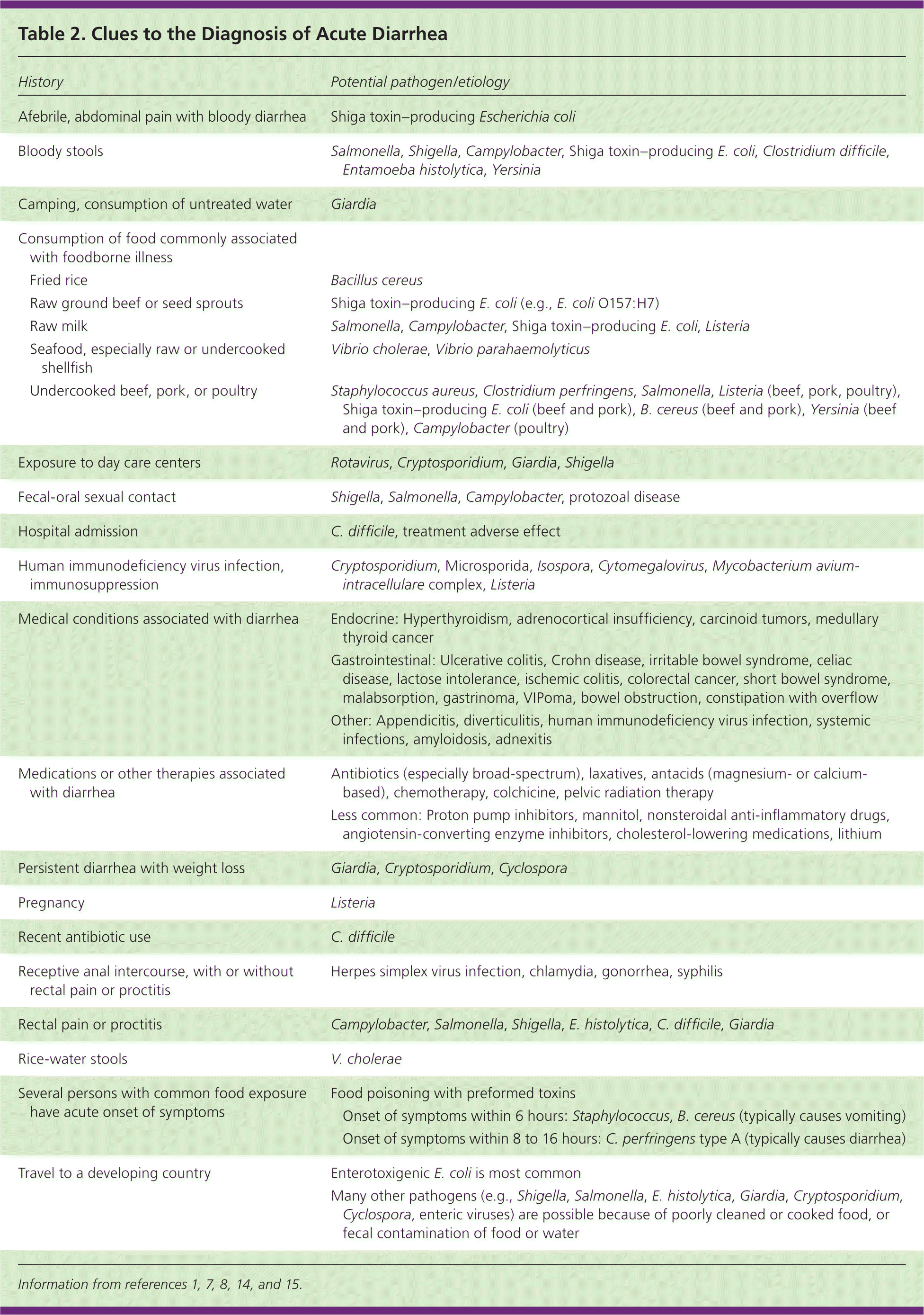
| History | Potential pathogen/etiology | ||
|---|---|---|---|
| Afebrile, abdominal pain with bloody diarrhea | Shiga toxin–producing Escherichia coli | ||
| Bloody stools | Salmonella, Shigella, Campylobacter, Shiga toxin–producing E. coli, Clostridium difficile, Entamoeba histolytica, Yersinia | ||
| Camping, consumption of untreated water | Giardia | ||
| Consumption of food commonly associated with foodborne illness | |||
| Fried rice | Bacillus cereus | ||
| Raw ground beef or seed sprouts | Shiga toxin–producing E. coli (e.g., E. coli O157:H7) | ||
| Raw milk | Salmonella, Campylobacter, Shiga toxin–producing E. coli, Listeria | ||
| Seafood, especially raw or undercooked shellfish | Vibrio cholerae, Vibrio parahaemolyticus | ||
| Undercooked beef, pork, or poultry | Staphylococcus aureus, Clostridium perfringens, Salmonella, Listeria (beef, pork, poultry), Shiga toxin–producing E. coli (beef and pork), B. cereus (beef and pork), Yersinia (beef and pork), Campylobacter (poultry) | ||
| Exposure to day care centers | Rotavirus, Cryptosporidium, Giardia, Shigella | ||
| Fecal-oral sexual contact | Shigella, Salmonella, Campylobacter, protozoal disease | ||
| Hospital admission | C. difficile, treatment adverse effect | ||
| Human immunodeficiency virus infection, immunosuppression | Cryptosporidium, Microsporida, Isospora, Cytomegalovirus, Mycobacterium aviumintracellulare complex, Listeria | ||
| Medical conditions associated with diarrhea | Endocrine: Hyperthyroidism, adrenocortical insufficiency, carcinoid tumors, medullary thyroid cancer | ||
| Gastrointestinal: Ulcerative colitis, Crohn disease, irritable bowel syndrome, celiac disease, lactose intolerance, ischemic colitis, colorectal cancer, short bowel syndrome, malabsorption, gastrinoma, VIPoma, bowel obstruction, constipation with overflow | |||
| Other: Appendicitis, diverticulitis, human immunodeficiency virus infection, systemic infections, amyloidosis, adnexitis | |||
| Medications or other therapies associated with diarrhea | Antibiotics (especially broad-spectrum), laxatives, antacids (magnesium- or calcium-based), chemotherapy, colchicine, pelvic radiation therapy | ||
| Less common: Proton pump inhibitors, mannitol, nonsteroidal anti-inflammatory drugs, angiotensin-converting enzyme inhibitors, cholesterol-lowering medications, lithium | |||
| Persistent diarrhea with weight loss | Giardia, Cryptosporidium, Cyclospora | ||
| Pregnancy | Listeria | ||
| Recent antibiotic use | C. difficile | ||
| Receptive anal intercourse, with or without rectal pain or proctitis | Herpes simplex virus infection, chlamydia, gonorrhea, syphilis | ||
| Rectal pain or proctitis | Campylobacter, Salmonella, Shigella, E. histolytica, C. difficile, Giardia | ||
| Rice-water stools | V. cholerae | ||
| Several persons with common food exposure have acute onset of symptoms | Food poisoning with preformed toxins | ||
| Onset of symptoms within 6 hours: Staphylococcus, B. cereus (typically causes vomiting) | |||
| Onset of symptoms within 8 to 16 hours: C. perfringens type A (typically causes diarrhea) | |||
| Travel to a developing country | Enterotoxigenic E. coli is most common | ||
| Many other pathogens (e.g., Shigella, Salmonella, E. histolytica, Giardia, Cryptosporidium, Cyclospora, enteric viruses) are possible because of poorly cleaned or cooked food, or fecal contamination of food or water | |||
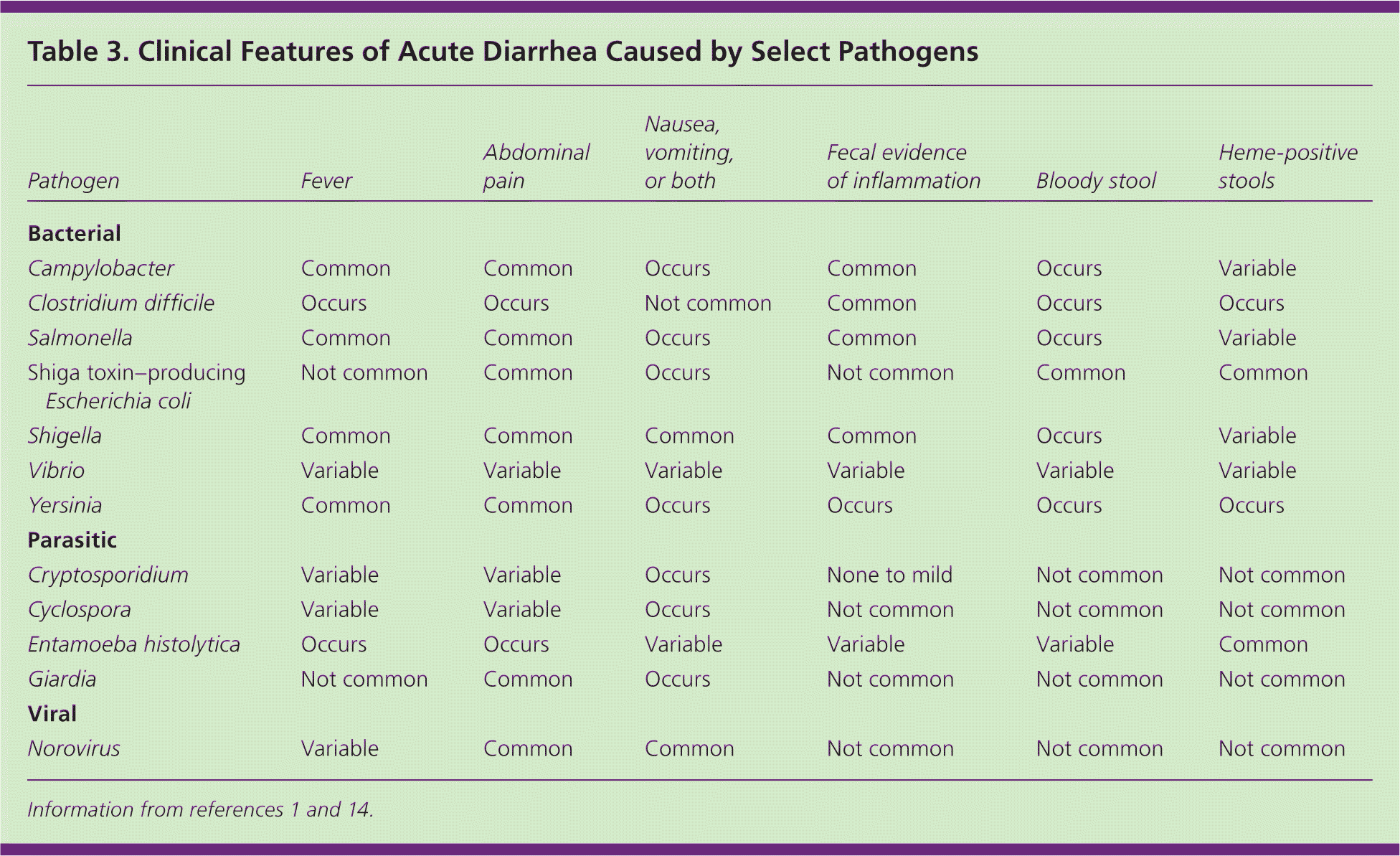
| Pathogen | Fever | Abdominal pain | Nausea, vomiting, or both | Fecal evidence of inflammation | Bloody stool | Heme-positive stools |
|---|---|---|---|---|---|---|
| Bacterial | ||||||
| Campylobacter | Common | Common | Occurs | Common | Occurs | Variable |
| Clostridium difficile | Occurs | Occurs | Not common | Common | Occurs | Occurs |
| Salmonella | Common | Common | Occurs | Common | Occurs | Variable |
| Shiga toxin–producing Escherichia coli | Not common | Common | Occurs | Not common | Common | Common |
| Shigella | Common | Common | Common | Common | Occurs | Variable |
| Vibrio | Variable | Variable | Variable | Variable | Variable | Variable |
| Yersinia | Common | Common | Occurs | Occurs | Occurs | Occurs |
| Parasitic | ||||||
| Cryptosporidium | Variable | Variable | Occurs | None to mild | Not common | Not common |
| Cyclospora | Variable | Variable | Occurs | Not common | Not common | Not common |
| Entamoeba histolytica | Occurs | Occurs | Variable | Variable | Variable | Common |
| Giardia | Not common | Common | Occurs | Not common | Not common | Not common |
| Viral | ||||||
| Norovirus | Variable | Common | Common | Not common | Not common | Not common |
PHYSICAL EXAMINATION
The primary goal of the physical examination is to assess the patient's degree of dehydration. Generally ill appearance, dry mucous membranes, delayed capillary refill time, increased heart rate, and abnormal orthostatic vital signs can be helpful in identifying more severe dehydration. Fever is more suggestive of inflammatory diarrhea. The abdominal examination is important to assess for pain and acute abdominal processes. A rectal examination may be helpful in assessing for blood, rectal tenderness, and stool consistency.
Diagnostic Testing
Because most watery diarrhea is self-limited, testing is usually not indicated.1,16 In general, specific diagnostic investigation can be reserved for patients with severe dehydration, more severe illness, persistent fever, bloody stool, or immunosuppression, and for cases of suspected nosocomial infection or outbreak.
OCCULT BLOOD
It is unclear how much fecal occult blood testing affects pretest probability. Nevertheless, it is a rapid and inexpensive test, and when tests are positive for fecal occult blood in conjunction with the presence of fecal leukocytes or lactoferrin, the diagnosis of inflammatory diarrhea is more common.17 Of note, fecal occult blood testing is 71% sensitive and 79% specific for inflammatory diarrhea in developed countries, but the sensitivity drops to 44% and specificity to 72% in developing countries.18
LEUKOCYTES AND LACTOFERRIN
Testing stool for leukocytes to screen for inflammatory diarrhea poses several challenges, including the handling of specimens and the standardization of laboratory processing and interpretation. There is a wide variability in sensitivity and specificity. Therefore, this testing has fallen out of favor.18
Lactoferrin is a marker for leukocytes that is released by damaged or deteriorating cells, and increases in the setting of bacterial infections.19 Commercially available immunoassay testing kits are a more precise and less variable method for specimen analysis compared with fecal leukocytes, with a sensitivity greater than 90% and a specificity greater than 70%.20 Although there is some debate as to whether fecal lactoferrin is clearly superior to fecal leukocytes, the speed and simplicity of lactoferrin testing make it the preferred method to screen for the presence of leukocytes when indicated.21
STOOL CULTURES
The indiscriminate use of stool cultures in the evaluation of acute diarrhea is inefficient (results are positive in only 1.6% to 5.6% of cases)1 and expensive, with an estimated cost of $900 to $1,200 per positive stool culture.22 Obtaining cultures only in patients with screening tests positive for leukocytes decreases the cost to $150 per positive culture.23 Obtaining cultures only in patients with grossly bloody stools increases the yield for positive culture results to greater than 30%.24
Although there is no consensus on which patients need a culture, it is reasonable to perform a culture if the patient has grossly bloody stool, severe dehydration, signs of inflammatory disease, symptoms lasting more than three to seven days, or immunosuppression.25,26 Cultures are often obtained for traveler's diarrhea; however, empiric treatment is also an option.1,11 In the hospital setting, cultures should be reserved for the reasons listed above or if diarrhea begins more than three days after admission and there has been a nosocomial outbreak, the patient has human immunodeficiency virus infection or neutropenia, or the patient is older than 65 years with significant comorbidity (e.g., end-stage liver, renal, or pulmonary disease; leukemia hemiparesis caused by cardiovascular accident; inflammatory bowel disease).25
CLOSTRIDIUM DIFFICILE TESTING
Testing for Clostridium difficile toxins A and B is recommended for patients who develop unexplained diarrhea after three days of hospitalization; the test will be positive in 15% to 20% of these patients.25,27 Furthermore, the risk of contracting C. difficile infection increases by seven to 10 times throughout any period of antibiotic treatment and for the first month after antibiotic discontinuation, and this risk is still three times higher in the second and third months after antibiotic discontinuation.28 Therefore, testing for C. difficile toxins is also suggested in patients who develop unexplained diarrhea while using antibiotics or within three months of discontinuing antibiotics. C. difficile testing can be considered in certain populations with significant comorbidities, including older persons and those who are immunocompromised.
OVA AND PARASITES
Routine analysis for ova and parasites in patients with acute diarrhea is not cost-effective, especially in developed countries.29 Indications for ova and parasite testing include persistent diarrhea lasting more than seven days, especially if associated with infants in day care or travel to mountainous regions; diarrhea in persons with AIDS or men who have sex with men; community waterborne outbreaks; or bloody diarrhea with few fecal leukocytes.11 The benefit of sending multiple samples to increase the test yield is debatable.
ENDOSCOPY
The role of endoscopy in the diagnosis and management of acute diarrhea is limited. Endoscopic evaluation may be considered if the diagnosis is unclear after routine blood and stool tests, if empiric therapy is ineffective, or if symptoms persist.30 Specifically, lower endoscopy with colonic biopsy and culture can be helpful in patients with diarrhea and suspected tuberculosis or diffuse colitis (as in C. difficile colitis) and in determining noninfectious causes of acute diarrhea, such as inflammatory bowel disease, ischemic colitis, enteropathy related to nonsteroidal anti-inflammatory drug use, and cancer.31
Treatment
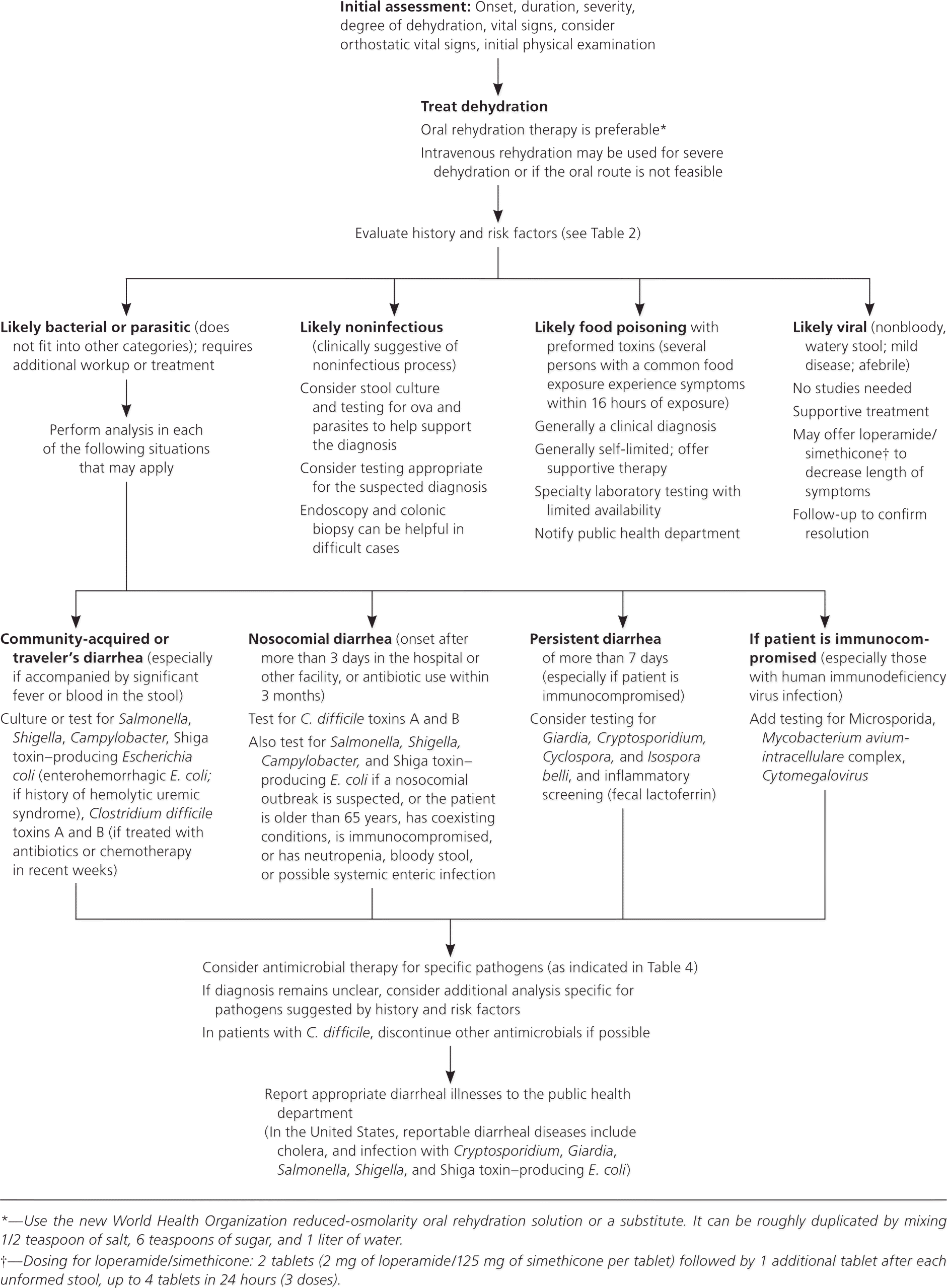
REHYDRATION THERAPY
The first step to treating acute diarrhea is rehydration, preferably oral rehydration.1 The accumulated fluid deficit (calculated roughly as the difference between the patient's normal weight and his or her weight at presentation with diarrheal illness) must first be addressed. Next, the focus should turn to the replacement of ongoing losses and the continuation of maintenance fluids. An oral rehydration solution (ORS) must contain a mixture of salt and glucose in combination with water to best use the intestine's sodium-glucose coupled cellular transport mechanism.
In 2002, the World Health Organization endorsed an ORS with reduced osmolarity (250 mOsm per L or less compared with the prior standard of 311 mOsm per L). The reduced osmolarity ORS decreases stool outputs, episodes of emesis, and the need for intravenous rehydration,32 without increasing hyponatremia, compared with the standard ORS.33 A reduced osmolarity ORS can be roughly duplicated by mixing 1/2 teaspoon of salt, 6 teaspoons of sugar, and 1 liter of water. If oral rehydration is not feasible, intravenous rehydration may be necessary.
FEEDING
Early refeeding decreases intestinal permeability caused by infections, reduces illness duration, and improves nutritional outcomes.34,35 This is particularly important in developing countries where underlying preexisting malnutrition is often a factor. Although the BRAT diet (bananas, rice, applesauce, and toast) and the avoidance of dairy are commonly recommended, supporting data for these interventions are limited. Instructing patients to refrain from eating solid food for 24 hours also does not appear useful.36
ANTIDIARRHEAL MEDICATIONS
The antimotility agent loperamide (Imodium) may reduce the duration of diarrhea by as much as one day and increase the likelihood of clinical cure at 24 and 48 hours when given with antibiotics for traveler's diarrhea.37,38 A loperamide/simethicone combination has demonstrated faster and more complete relief of acute nonspecific diarrhea and gas-related discomfort compared with either medication alone.39
Loperamide may cause dangerous prolongation of illness in patients with some forms of bloody or inflammatory diarrhea and, therefore, should be restricted to patients with nonbloody stool.40 The antisecretory drug bismuth subsalicylate (Pepto-Bismol) is a safe alternative in patients with fever and inflammatory diarrhea. There is inadequate evidence to recommend the use of the absorbents kaolin/pectin, activated charcoal, or attapulgite (no longer available in the United States). The antisecretory drug racecadotril, widely used in Europe but unavailable in the United States, appears to be more tolerable and as effective as loperamide.41
ANTIBIOTIC THERAPY
Because acute diarrhea is most often self-limited and caused by viruses, routine antibiotic use is not recommended for most adults with nonsevere, watery diarrhea. Additionally, the overuse of antibiotics can lead to resistance (e.g., Campylobacter), harmful eradication of normal flora, prolongation of illness (e.g., superinfection with C. difficile), prolongation of carrier state (e.g., delayed excretion of Salmonella), induction of Shiga toxins (e.g., from Shiga toxin–producing E. coli), and increased cost.
However, when used appropriately, antibiotics are effective for shigellosis, campylobacteriosis, C. difficile, traveler's diarrhea, and protozoal infections. Antibiotic treatment of traveler's diarrhea (usually a quinolone) is associated with decreased severity of illness and a two-or three-day reduction in duration of illness.1,42 If the patient's clinical presentation suggests the possibility of Shiga toxin–producing E. coli (e.g., bloody diarrhea, history of eating seed sprouts or rare ground beef, proximity to an outbreak), antibiotic use should be avoided because it may increase the risk of hemolytic uremic syndrome.43 Conservative management without antibiotic treatment is less successful for diarrhea lasting more than 10 to 14 days, and testing and treatment for protozoal infections should be considered.1 Antibiotics may be considered in patients who are older than 65 years, immunocompromised, severely ill, or septic. Table 4 summarizes antibiotic therapy for acute diarrhea.1,14,16,44,45
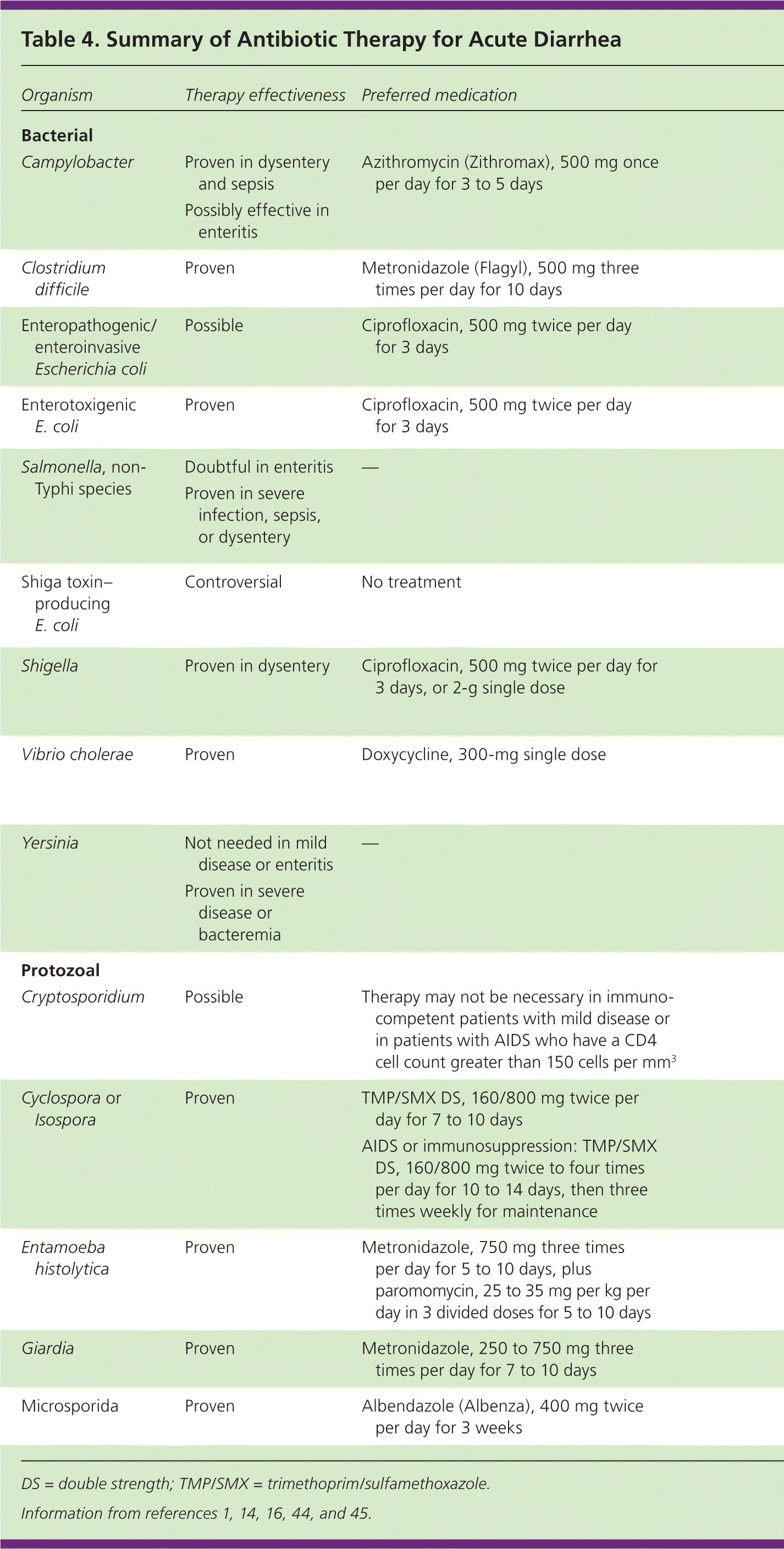
| Organism | Therapy effectiveness | Preferred medication | Alternative medications | Comments |
|---|---|---|---|---|
| Bacterial | ||||
| Campylobacter | Proven in dysentery and sepsis, possibly effective in enteritis | Azithromycin (Zithromax), 500 mg once per day for 3 to 5 days | Erythromycin, 500 mg four times per day for 3 to 5 days | Consider prolonged treatment if the patient is immunocompromised |
| Ciprofloxacin (Cipro), 500 mg twice per day for 5 to7 days | ||||
| Clostridium difficile | Proven | Metronidazole (Flagyl), 500 mg three times per day for 10 days | Vancomycin, 125 mg four times per day for 10 days | If an antimicrobial agent is causing the diarrhea, it should be discontinued if possible |
| Enteropathogenic/enteroinvasive Escherichia coli | Possible | Ciprofloxacin, 500 mg twice per day for 3 days | TMP/SMX DS, 160/800 mg twice per day for 3 days | — |
| Enterotoxigenic E. coli | Proven | Ciprofloxacin, 500 mg twice per day for 3 days | TMP/SMX DS, 160/800 mg twice per day for 3 days | Enterotoxigenic E. coli is the most common cause of traveler's diarrhea |
| Azithromycin, 500 mg per day for 3 days | ||||
| Salmonella, non-Typhi species | Doubtful in enteritis; proven in severe infection, sepsis, or dysentery | — | Options for severe disease: Ciprofloxacin, 500 mg twice per day for 5 to 7 days | In addition to patients with severe disease, it is appropriate to treat patients younger than 12 months or older than 50 years, and patients with a prosthesis, valvular heart disease, severe atherosclerosis, malignancy, or uremia |
| TMP/SMX DS, 160/800 mg twice per day for 5 to 7 days | ||||
| Azithromycin, 500 mg per day for 5 to 7 days | Patients who are immunocompromised should be treated for 14 days | |||
| Shiga toxin–producing E. coli | Controversial | No treatment | No treatment | The role of antibiotics is unclear; they are generally avoided because of their association with hemolytic uremic syndrome |
| Antimotility agents should be avoided | ||||
| Shigella | Proven in dysentery | Ciprofloxacin, 500 mg twice per day for 3 days, or 2-g single dose | Azithromycin, 500 mg twice per day for 3 days | Use of TMP/SMX is limited because of resistance |
| TMP/SMX DS, 160/800 mg twice per day for 5 days | Patients who are immunocompromised should be treated for 7 to 10 days | |||
| Ceftriaxone (Rocephin), 2- to 4-g single dose | ||||
| Vibrio cholerae | Proven | Doxycycline, 300-mg single dose | Azithromycin, 1-g single dose | Doxycycline and tetracycline are not recommended in children because of possible tooth discoloration |
| Tetracycline, 500 mg four times per day for 3 days | ||||
| TMP/SMX DS, 160/800 mg twice per day for 3 days | ||||
| Yersinia | Not needed in mild disease or enteritis, proven in severe disease or bacteremia | — | Options for severe disease: | — |
| Doxycycline combined with an aminoglycoside | ||||
| TMP/SMX DS, 160/800 mg twice per day for 5 days | ||||
| Ciprofloxacin, 500 mg twice per day for 7 to 10 days | ||||
| Protozoal | ||||
| Cryptosporidium | Possible | Therapy may not be necessary in immunocompetent patients with mild disease or in patients with AIDS who have a CD4 cell count greater than 150 cells per mm3 | Option for severe disease: Nitazoxanide (Alinia), 500 mg twice per day for 3 days (may offer longer treatment for refractory cases in patients with AIDS) | Highly active antiretroviral therapy, which achieves immune reconstitution, is adequate to eradicate intestinal disease in patients with AIDS |
| Cyclospora or Isospora | Proven | TMP/SMX DS, 160/800 mg twice per day for 7 to 10 days | — | — |
| AIDS or immunosuppression: TMP/SMX DS, 160/800 mg twice to four times per day for 10 to 14 days, then three times weekly for maintenance | ||||
| Entamoeba histolytica | Proven | Metronidazole, 750 mg three times per day for 5 to 10 days, plus paromomycin, 25 to 35 mg per kg per day in 3 divided doses for 5 to 10 days | Tinidazole (Tindamax), 2 g per day for 3 days, plus paromomycin, 25 to 35 mg per kg per day in 3 divided doses for 5 to 10 days | If the patient has severe disease or extraintestinal infection, including hepatic abscess, serology will be positive |
| Giardia | Proven | Metronidazole, 250 to 750 mg three times per day for 7 to 10 days | Tinidazole, 2-g single dose | Relapses may occur |
| Microsporida | Proven | Albendazole (Albenza), 400 mg twice per day for 3 weeks | — | Highly active antiretroviral therapy, which achieves immune reconstitution, is adequate to eradicate intestinal disease in patients with AIDS |
PROBIOTICS
Probiotics are thought to work by stimulating the immune system and competing for binding sites on intestinal epithelial cells. Their use in children with acute diarrhea is associated with reduced severity and duration of illness (an average of about one less day of illness).46 Although many species are generally categorized as probiotics, even closely related strains may have different clinical effects. Effects of strain-specific probiotics need to be verified in adult studies before a specific evidence-based recommendation can be made.16
ZINC SUPPLEMENTATION
Research in children suggests that zinc supplementation (20 mg per day for 10 days in children older than two months) may play a crucial role in treating and preventing acute diarrhea, particularly in developing countries. Studies demonstrate a decrease in the risk of dehydration, and in the duration and severity of the diarrheal episode by an estimated 20% to 40%.47 Additional research is needed to evaluate potential benefits of zinc supplementation in the adult population.
Prevention
Good hygiene, hand washing, safe food preparation, and access to clean water are key factors in preventing diarrheal illness.48 Public health interventions to promote hand washing alone can reduce the incidence of diarrhea by about one-third.49 Vaccine development remains a high priority for disease prevention, particularly for those in the developing world. Effective and safe vaccines exist for rotavirus, typhoid fever, and cholera, and are under investigation for Campylobacter, enterotoxigenic E. coli, and Shigella infections. To contain disease outbreaks, designated diseases should be reported to public health authorities. In the United States, reportable diarrheal illnesses include those caused by Vibrio cholerae, Cryptosporidium, Giardia, Salmonella, Shigella, and Shiga toxin–producing E. coli.
Data Sources: A literature search was completed in Medline via Ovid, EBSCOhost, DynaMed, Essential Evidence Plus, and the Cochrane Database of Systematic Reviews. Keywords were acute diarrhea, evaluation of acute diarrhea, Clostridium difficile, testing in acute diarrhea, and diagnostic testing in acute diarrhea. Search dates: March to April 2011, and December 2013.
